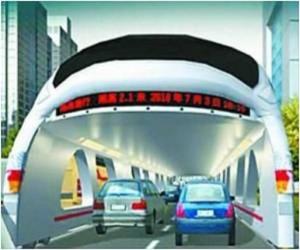InfrastructureElevated super bus to solve Beijing's traffic woes
Beijing and Mexico City vie for the title of the city with the worst traffic jams in the world; Beijing is now looking at an elevated “super bus” as a possible solution; the bus travels on rails and straddles two lanes of traffic, allowing cars to drive under its passenger compartment, which holds up to 1,400 people

Proposed "super bus" // Source: medindia.net
China’s capital Beijing, recently named along with Mexico City as having the worst traffic jams in the world, is looking for solutions. One could be the elevated “super bus.”
The bus, due to be tested in the coming months in the western part of the city, travels on rails and straddles two lanes of traffic, allowing cars to drive under its passenger compartment, which holds up to 1,400 people.
“We’re going to start laying down test tracks along a 6-kilometer stretch towards the end of the year,” Song Youzhou, the chief executive of design firm Shenzhen Hashi Future Parking Equipment, told AFP on Tuesday. “From the second half of 2011, we’re planning to test the bus with passengers on board,” he said, noting that after a full year of trial runs, authorities would make a decision on whether to use the bus on a wide scale.
Song said Hashi was in talks with three Chinese carmakers to produce the eco-friendly bus, which runs on both electricity and solar power.
Authorities hope eventually to install 180 kilometers of “straddle bus” lines including a route to the capital’s international airport, Song told the official
Song said the super bus could ease traffic congestion by up to 30 percent, as it does not take up actual road space, but special tracks would have to be put down, elevated bus stops built and new traffic signals developed.
Song said the bus had to be tested with car drivers in real-time situations to detect any possible problems.
According to government data, Beijing is on track to have five million cars on its roads by year’s end. The four million mark was passed in December.
The head of the Beijing Transportation Research Centre, Guo Jifu, warned this week that traffic in the capital could slow to under 15 kilometers an hour on average if further measures were not taken to limit the number of cars.
Private cars are currently kept off Beijing’s roads for one day per week depending on license plate numbers.
Beijing’s air is among the most polluted in the world, and the problem is getting worse amid high demand for private vehicles from its increasingly affluent residents.
